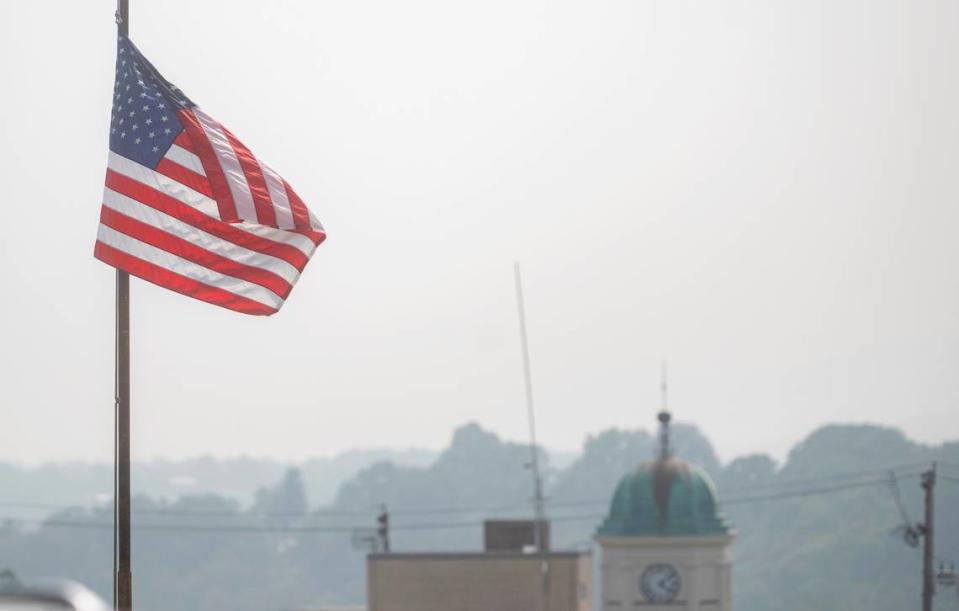PA air quality update: ‘Code Red’ issued for Friday. What does it mean for you?
Ongoing smoke and haze from wildfires in Canada will produce another day of sub-par air quality on Friday for much of the Northeast, including Pennsylvania.
The Keystone State is under a “Code Red Air Quality Action Day” on Friday, according to the Pennsylvania Department of Environmental Protection. The issuance comes amid a forecast of Air Quality Index readings in the orange (unhealthy for sensitive groups) and red (unhealthy) ratings on Friday, though conditions are expected to improve throughout the day.
The highest concentrations of unhealthy air were expected Friday morning, the DEP wrote in a statement. As of 1 p.m., airnow.gov reports State College’s Air Quality Index score at 169, firmly in the red rating, which is the third-highest level.
According to the DEP, the primary pollutants in wildfire smoke are likened to mechanical exhaust, among other sources.
“Fine particulate matter (or PM-2.5) comes in many sizes and shapes and can be made up of hundreds of different chemicals. Some are emitted directly from a source, such as construction sites, unpaved roads, fields, smokestacks, or fires,” the agency wrote. “Most particles form in the atmosphere as a result of complex reactions of chemicals such as sulfur dioxide and nitrogen oxides (called “precursors”), which are pollutants emitted from power plants, industries, and automobiles.”
Poor air quality can be hazardous to anyone. Before spending time outdoors, check the air quality forecast to ensure that you aren’t doing yourself more harm than good.https://t.co/CVx9g8Hm1q pic.twitter.com/wXKFIgRa4O
— National Weather Service (@NWS) June 29, 2023
What does poor air quality in Pennsylvania mean for me?
Pennsylvania officials expect average conditions will settle into the orange rating later on Friday. Regardless, residents are encouraged to limit their time outside.
“On a Code Red Air Quality Action Day, young children, the elderly, and those with respiratory problems, such as asthma, emphysema, and bronchitis, are especially vulnerable to the effects of air pollution and should avoid outdoor activities, and everyone else should reduce prolonged or heavy exertion,” the DEP wrote.
Air quality readings categorized as unhealthy for sensitive groups can still impact an average person’s health. An eight-hour workday spent outdoors during an orange-rated Air Quality Index score of 145, for example, is roughly equivalent to smoking a cigarette, one air quality calculator reports. That metric jumps to nearly three cigarettes following a full 24 hours outdoors.
The State College area is expected to improve to “moderate” air quality on Saturday, according to airnow.gov.

Reducing exposure to poor air quality
You can take a number of steps to reduce your exposure to unhealthy air, the Pennsylvania Department of Health advises.
If you’re heading outdoors, you can cut down on exposure risk by:
Avoiding strenuous outdoor activities
Keeping outdoor activities short
Working to move physical activities, including workouts or recess, indoors or rescheduling them entirely
At home, consider taking the following steps to limit indoor exposure:
Keep doors and windows closed.
Don’t smoke or use candles indoors.
Use an air filter in your home if you have one.
Clean or replace filters according to manufacturer recommendations.
Consider crafting a do-it-yourself portable air cleaner to reduce particles indoors. Instructions are available online at epa.gov/system/files/documents/2021-09/diy-air-purifier-infographic_final.pdf.
Q: How can I keep particle pollution lower indoors?
A: Follow these tips:
don’t use candles or smoke indoors
keep windows/doors closed
use air filter if you have one
make a DIY portable air cleaner: https://t.co/MqZpJd5yP5
clean/replace filters— PA Department of Health (@PAHealthDept) June 28, 2023
If you’re using a mask to protect yourself, look for “particulate respirators” to combat smoke pollutants.
How to check air quality in your area
You can visit airnow.gov to look up air quality readings for your ZIP code, city or state. The tool, provided by the U.S. Environmental Protection Agency, also offers suggestions to avoid exposure, plus live map readings, forecasts and graphics to break down critical air quality information.
The EPA also offers an AirNow mobile app for free on the Apple App Store and Google Play Store.

